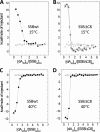Regulation of single-stranded DNA binding by the C termini of Escherichia coli single-stranded DNA-binding (SSB) protein
- PMID: 20360609
- PMCID: PMC2878057
- DOI: 10.1074/jbc.M110.118273
Regulation of single-stranded DNA binding by the C termini of Escherichia coli single-stranded DNA-binding (SSB) protein
Abstract
The homotetrameric Escherichia coli single-stranded DNA-binding (SSB) protein plays a central role in DNA replication, repair, and recombination. In addition to its essential activity of binding to transiently formed single-stranded (ss) DNA, SSB also binds an array of partner proteins and recruits them to their sites of action using its four intrinsically disordered C-terminal tails. Here we show that the binding of ssDNA to SSB is inhibited by the SSB C-terminal tails, specifically by the last 8 highly acidic amino acids that comprise the binding site for its multiple partner proteins. We examined the energetics of ssDNA binding to short oligodeoxynucleotides and find that at moderate salt concentration, removal of the acidic C-terminal ends increases the intrinsic affinity for ssDNA and enhances the negative cooperativity between ssDNA binding sites, indicating that the C termini exert an inhibitory effect on ssDNA binding. This inhibitory effect decreases as the salt concentration increases. Binding of ssDNA to approximately half of the SSB subunits relieves the inhibitory effect for all of the subunits. The inhibition by the C termini is due primarily to a less favorable entropy change upon ssDNA binding. These observations explain why ssDNA binding to SSB enhances the affinity of SSB for its partner proteins and suggest that the C termini of SSB may interact, at least transiently, with its ssDNA binding sites. This inhibition and its relief by ssDNA binding suggest a mechanism that enhances the ability of SSB to selectively recruit its partner proteins to sites on DNA.
Figures





Similar articles
-
Intrinsically disordered C-terminal tails of E. coli single-stranded DNA binding protein regulate cooperative binding to single-stranded DNA.J Mol Biol. 2015 Feb 27;427(4):763-774. doi: 10.1016/j.jmb.2014.12.020. Epub 2015 Jan 3. J Mol Biol. 2015. PMID: 25562210 Free PMC article.
-
Binding specificity of Escherichia coli single-stranded DNA binding protein for the chi subunit of DNA pol III holoenzyme and PriA helicase.Biochemistry. 2010 May 4;49(17):3555-66. doi: 10.1021/bi100069s. Biochemistry. 2010. PMID: 20329707 Free PMC article.
-
Multiple C-terminal tails within a single E. coli SSB homotetramer coordinate DNA replication and repair.J Mol Biol. 2013 Nov 29;425(23):4802-19. doi: 10.1016/j.jmb.2013.08.021. Epub 2013 Sep 7. J Mol Biol. 2013. PMID: 24021816 Free PMC article.
-
Molecular insights into the prototypical single-stranded DNA-binding protein from E. coli.Crit Rev Biochem Mol Biol. 2024 Feb-Apr;59(1-2):99-127. doi: 10.1080/10409238.2024.2330372. Epub 2024 May 21. Crit Rev Biochem Mol Biol. 2024. PMID: 38770626 Free PMC article. Review.
-
The mechanism of action of the SSB interactome reveals it is the first OB-fold family of genome guardians in prokaryotes.Protein Sci. 2021 Sep;30(9):1757-1775. doi: 10.1002/pro.4140. Epub 2021 Jun 14. Protein Sci. 2021. PMID: 34089559 Free PMC article. Review.
Cited by
-
Single-stranded DNA binding protein hitches a ride with the Escherichia coli YoaA-χ helicase.bioRxiv [Preprint]. 2024 Jun 21:2024.06.21.600097. doi: 10.1101/2024.06.21.600097. bioRxiv. 2024. PMID: 38948847 Free PMC article. Preprint.
-
Are the SSB-Interacting Proteins RecO, RecG, PriA and the DnaB-Interacting Protein Rep Bound to Progressing Replication Forks in Escherichia coli?PLoS One. 2015 Aug 5;10(8):e0134892. doi: 10.1371/journal.pone.0134892. eCollection 2015. PLoS One. 2015. PMID: 26244508 Free PMC article.
-
Plasmodium falciparum SSB tetramer binds single-stranded DNA only in a fully wrapped mode.J Mol Biol. 2012 Jul 20;420(4-5):284-95. doi: 10.1016/j.jmb.2012.04.022. Epub 2012 Apr 26. J Mol Biol. 2012. PMID: 22543238 Free PMC article.
-
The C-terminal tails of the mitochondrial transcription factors Mtf1 and TFB2M are part of an autoinhibitory mechanism that regulates DNA binding.J Biol Chem. 2020 May 15;295(20):6823-6830. doi: 10.1074/jbc.RA120.013338. Epub 2020 Apr 2. J Biol Chem. 2020. PMID: 32241911 Free PMC article.
-
ssb gene duplication restores the viability of ΔholC and ΔholD Escherichia coli mutants.PLoS Genet. 2014 Oct 16;10(10):e1004719. doi: 10.1371/journal.pgen.1004719. eCollection 2014 Oct. PLoS Genet. 2014. PMID: 25329071 Free PMC article.
References
Publication types
MeSH terms
Substances
Grants and funding
LinkOut - more resources
Full Text Sources
Other Literature Sources
Molecular Biology Databases

